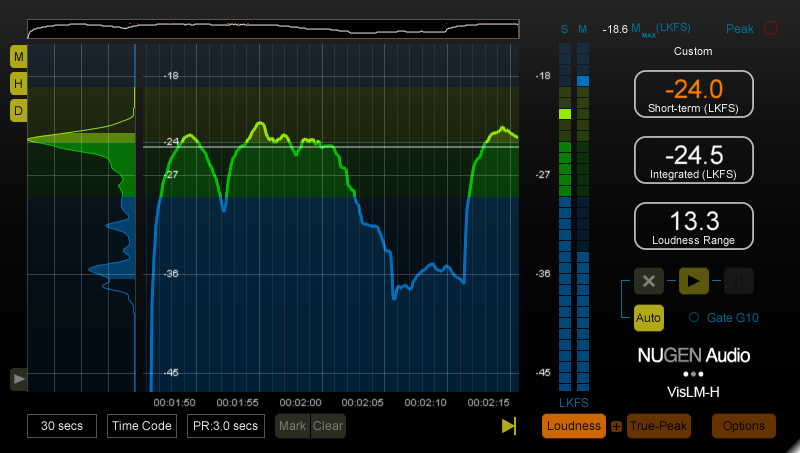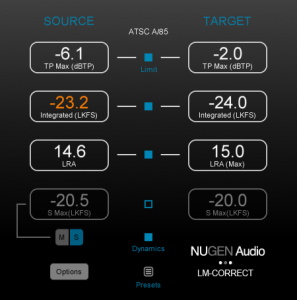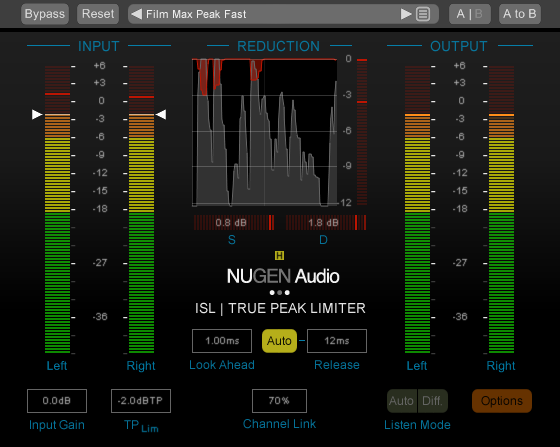Broadcast delivery specs are non-negotiable. Miss them, and you risk rejections, revisions, or worse — reputational damage. But loudness compliance doesn’t have to be complicated. With the right understanding and the right tools, you can confidently deliver pristine, spec-compliant audio every time.
This isn’t just theory — it’s what audio professionals across the UK, Europe, USA and beyond do daily with the help of NUGEN Audio’s Loudness Toolkit.
Why Loudness Matters in Broadcast
Broadcast loudness is about consistency and listener comfort, not just how “loud” a track appears on meters. When loudness levels jump between programmes, adverts or streaming content, it creates a jarring, unprofessional experience — and often fails QC.
For example, a podcast repurposed for broadcast with no loudness check may breach True Peak thresholds — even if LUFS appears compliant.
Broadcast and streaming platforms enforce loudness standards to ensure a consistent listening experience as audiences move between content types and delivery platforms.
What Happens When You Don’t Comply?
- Your content might be rejected or muted.
- You may face penalties or rework fees.
- Some platforms apply automated normalisation — but this only works if your mix is clean.
Loudness 101 – Key Terms Explained Simply
To understand compliance, you first need to speak the language of loudness. Here are the fundamentals, explained in plain terms:
| Term | What It Means | Practical Explanation | Simple Analogy |
|---|---|---|---|
| LUFS (Loudness Units relative to Full Scale) | Measures perceived loudness, considering how humans actually hear | Integrates both volume and frequency sensitivity to give a realistic loudness measurement | "How loud it feels” to the human ear, not just how loud it is numerically |
| dBFS (Decibels relative to Full Scale) | Measures the digital signal level with 0 being the maximum limit, so most readings and targets will be negative numbers | Used to identify how close your audio is to clipping or distorting | Like a car’s speedometer — 0 dBFS is redline - go beyond it and you crash (clip) |
| True Peak (dBTP) | Detects peaks between digital samples that dBFS may miss | Prevents distortion caused by inter-sample peaks, especially on streaming platforms | Think of this as measuring the actual height of a bumpy road, not just the road signs |
| RMS (Root Mean Square) | Calculates the average audio power over time | Often used historically for loudness, but less accurate than LUFS for perceived loudness | Like calculating the average height of a wave without noticing its shape or sharpness |
| LRA (Loudness Range) | Measures the difference between loud and quiet parts over time | Helps to ensure the dynamic range is pleasant and not extreme for the audience | Like measuring how signficantly a conversation varies between whispers and shouts |
| Momentary & Short-Term LUFS | Measures loudness in short windows (400ms to 3s) | Identifies problematic spikes or short bursts that could breach compliance | Like spotting a sudden pothole in an otherwise smooth road |
Quick-Reference Loudness Standards (Global)
Different platforms and regions have different targets. Here’s a simplified reference table for broadcast and streaming specs:
| Platform / Region | Target LUFS | True Peak Limit | Notes |
|---|---|---|---|
| UK, Europe (EBU R128) | -23 LUFS ±1 LU | -1 dBTP | Used by BBC, ITV, Channel 4, Sky, ARTE, ZDF and most EU broadcasters |
| USA (ATSC A/85) | -24 LKFS ±2 LU | -2 dBTP | Standard for US broadcast, including cable and satellite TV |
| Japan (ARIB TR-B32) | -24 LKFS | -1 dBTP | Standard for Japanese broadcasters including NHK |
| Chinese (GY/T 282-2014) | -24 LKFS ±2 LU | -2 dBTP | Standard for Chinese broadcasters |
| Australia (OP-59) | -24 LKFS ±1 LU | –2 dBTP | Standard for Australian broadcasters |
| Netflix (Streaming) | -27 LKFS ±2 LU (dialog-gated) | -2.3 dBTP | Applies speech-gated measurement - requires detailed QC compliance |
| Disney+, HBO, STARZ (Streaming) | -27 LUFS ±2 LU (dialog-gated) | -2 dBTP | Similar to Netflix - often measured with dialog intelligence gating |
| Spotify (Music Streaming) | -14 LUFS (Normal), -11 LUFS (Loud), -19 LUFS (Quiet) | -1 dBTP | Spotify normalises to target level, depending on user settings. May also apply a limiter. |
| Apple Music (Stereo) | -16 LUFS ±1 LU | -1 dBTP | Apple Digital Masters requirement for stereo mixes |
| Apple Music (Dolby Atmos) | -18 LUFS ±1 LU | -1 dBTP | Apple Immersive Audio target (Atmos) |
| YouTube | -14 LUFS | -1 dBTP | Normalises to approx. -14 LUFS, but this is not always uniformly or consistently applied |
| Amazon Music / Alexa | -14 LUFS | -2 dBTP | Consistent with music streaming platform practices |
| Podcasts (Apple Podcasts, Spotify, others) | -16 LUFS ±1 LU typical | -1 dBTP | Generally accepted industry norm - platforms may apply light normalisation |
Tools You’ll Need for Broadcast Loudness Compliance
The following tools — built into NUGEN Audio’s Loudness Toolkit — are engineered to help you stay compliant under pressure.

VisLM
Real time loudness meter
- Monitor Integrated, Short-term and Momentary LUFS
- Visualise True Peak overs in context
- Set thresholds for instant feedback

LM-Correct
Automatic quick-fix compliance
- Auto-fixes Integrated LUFS and True Peak
- Ideal for legacy content or urgent deliveries
- Supports batch processing for series workflows

ISL
Precision True Peak limiter
- Prevents inter-sample clipping
- Ensures downstream platform normalisation stays clean
- Ideal for final delivery protection
Practical Workflow for Broadcast Compliance
Follow this workflow to build compliance into your mix from day one.
Set-Up
- Choose LUFS target (e.g. -23 for UK)
- Enable VisLM before you touch a fader
- Insert ISL on your master bus from the start
During Mix
- Watch momentary LUFS during transitions
- Keep an eye on LRA — don’t over-compress
- For multi-format: check stereo and surround fold-down
Finalise
- Run LM-Correct for final correction / validation
- Confirm LUFS, True Peak and LRA all meet spec
- Export with loudness metadata if required
Common Pitfalls — and How to Avoid Them
| Mistake | Risk | Fix |
|---|---|---|
| Relying only on peak meters | LUFS compliance not met despite safe peak levels - listeners perceive inconsistent loudness | Use LUFS metering (e.g., VisLM) to monitor Integrated, Short-term, and Momentary loudness |
| Leaving compliance checks until the end | Forces last-minute fixes that can flatten dynamics or degrade sound quality | Mix with loudness compliance in mind from the start, using real-time metering throughout the process |
| Ignoring regional loudness standards | Programme may be rejected or require costly reworking | Always check and apply relevant broadcaster or platform specifications (e.g., EBU R128, ATSC A/85, Netflix) |
| Over-compressing to “hit the target” | Results in lifeless, fatiguing audio | Balance dynamic control carefully - aim for an appropriate LRA (Loudness Range) rather than minimising it excessively |
| Neglecting True Peak compliance | Audio may pass LUFS but clip during downstream encoding or platform normalisation | Use a True Peak limiter (e.g., NUGEN ISL) and verify that peaks remain below the required limit |
| Forgetting metadata (when required) | Some platforms may interpret loudness data incorrectly, causing playback issues | Always embed required metadata on export if delivering to broadcasters or platforms that require it |
FAQs — What Engineers Ask Most
Q: What is the LUFS requirement for BBC broadcast?
A: BBC uses EBU R128, targeting -23 LUFS with a ±1 LU tolerance. True Peak must remain under -1 dBTP.
Q: Can I use VisLM with Adobe Premiere or Final Cut?
A: Yes — VisLM integrates with major DAWs and NLEs including Premiere Pro, Final Cut Pro, Pro Tools, Logic, and more.
Q: Is LM-Correct accurate enough for final delivery?
A: Absolutely. It’s trusted by teams delivering to BBC, Sky, Netflix, and global broadcasters.
Final Checklist – Before You Hit Export
✔ LUFS matches target spec
✔ True Peak under platform limit
✔ LRA is appropriate for content type
✔ Metadata embedded if needed
✔ Passed LM-Correct and/or VisLM checks
Why Post Teams Trust the Loudness Toolkit
- Real-time clarity with VisLM
- Fast offline correction via LM-Correct
- Compatible with global broadcast & streaming specs
- Works across platforms, DAWs and NLEs
- Built for professionals — no guesswork required
Ready to Take Control of Loudness?
You’re no longer mixing blind. The NUGEN Audio Loudness Toolkit gives you the insight, precision, and confidence to deliver audio that’s not just compliant — but exceptional.
Written by Dr Paul Tapper, CEO at NUGEN Audio — 20+ years experience in audio-software, member of the original EBU ploud group that set the R128 standard
External Links:
| Reference | URL |
|---|---|
| EBU R128 specification | https://tech.ebu.ch/docs/r/r128.pdf |
| ATSC A/85 specification | https://www.atsc.org/wp-content/uploads/2021/04/A85-2013.pdf |
| Netflix Sound Mix Specifications | https://partnerhelp.netflixstudios.com/hc/en-us/articles/360001794307-Netflix-Sound-Mix-Specifications-Best-Practices-v1-6 |
Share this